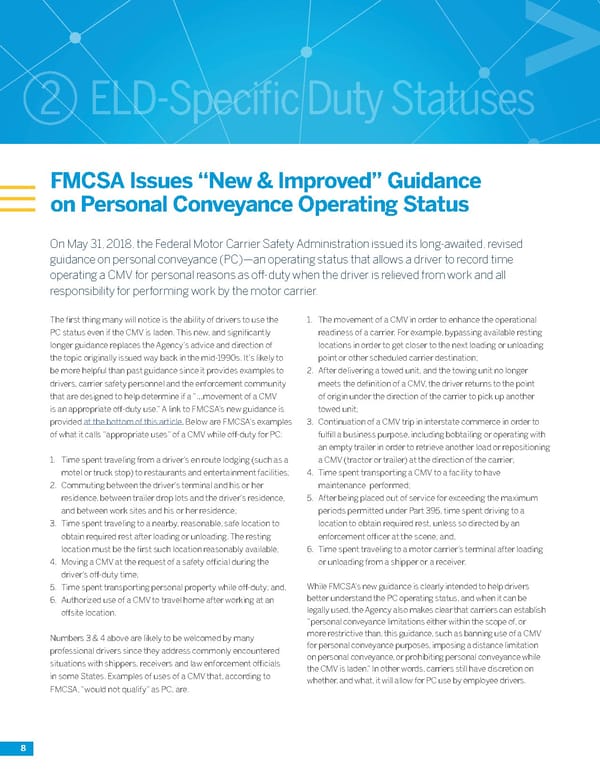8 2 ELD-Specific Duty Statuses The first thing many will notice is the ability of drivers to use the PC status even if the CMV is laden. This new, and significantly longer guidance replaces the Agency’s advice and direction of the topic originally issued way back in the mid-1990s. It’s likely to be more helpful than past guidance since it provides examples to drivers, carrier safety personnel and the enforcement community that are designed to help determine if a “...movement of a CMV is an appropriate off-duty use.” A link to FMCSA’s new guidance is provided at the bottom of this article. Below are FMCSA’s examples of what it calls “appropriate uses” of a CMV while off-duty for PC: 1. Time spent traveling from a driver’s en route lodging (such as a motel or truck stop) to restaurants and entertainment facilities; 2. Commuting between the driver’s terminal and his or her residence, between trailer drop lots and the driver’s residence, and between work sites and his or her residence; 3. Time spent traveling to a nearby, reasonable, safe location to obtain required rest after loading or unloading. The resting location must be the first such location reasonably available; 4. Moving a CMV at the request of a safety official during the driver’s off-duty time; 5. Time spent transporting personal property while off-duty; and, 6. Authorized use of a CMV to travel home after working at an offsite location. Numbers 3 & 4 above are likely to be welcomed by many professional drivers since they address commonly encountered situations with shippers, receivers and law enforcement officials in some States. Examples of uses of a CMV that, according to FMCSA, “would not qualify” as PC, are: 1. The movement of a CMV in order to enhance the operational readiness of a carrier. For example, bypassing available resting locations in order to get closer to the next loading or unloading point or other scheduled carrier destination; 2. After delivering a towed unit, and the towing unit no longer meets the definition of a CMV, the driver returns to the point of origin under the direction of the carrier to pick up another towed unit; 3. Continuation of a CMV trip in interstate commerce in order to fulfill a business purpose, including bobtailing or operating with an empty trailer in order to retrieve another load or repositioning a CMV (tractor or trailer) at the direction of the carrier; 4. Time spent transporting a CMV to a facility to have maintenance performed; 5. After being placed out of service for exceeding the maximum periods permitted under Part 395, time spent driving to a location to obtain required rest, unless so directed by an enforcement officer at the scene; and, 6. Time spent traveling to a motor carrier’s terminal after loading or unloading from a shipper or a receiver. While FMCSA’s new guidance is clearly intended to help drivers better understand the PC operating status, and when it can be legally used, the Agency also makes clear that carriers can establish “personal conveyance limitations either within the scope of, or more restrictive than, this guidance, such as banning use of a CMV for personal conveyance purposes, imposing a distance limitation on personal conveyance, or prohibiting personal conveyance while the CMV is laden.” In other words, carriers still have discretion on whether, and what, it will allow for PC use by employee drivers. On May 31, 2018, the Federal Motor Carrier Safety Administration issued its long-awaited, revised guidance on personal conveyance (PC)—an operating status that allows a driver to record time operating a CMV for personal reasons as off-duty when the driver is relieved from work and all responsibility for performing work by the motor carrier. FMCSA Issues “New & Improved” Guidance on Personal Conveyance Operating Status
 Roadmap to the ELD Mandate Page 7 Page 9
Roadmap to the ELD Mandate Page 7 Page 9